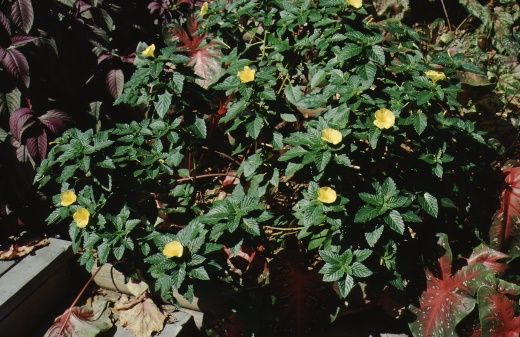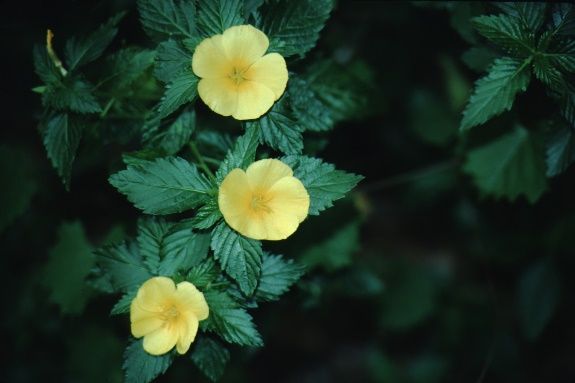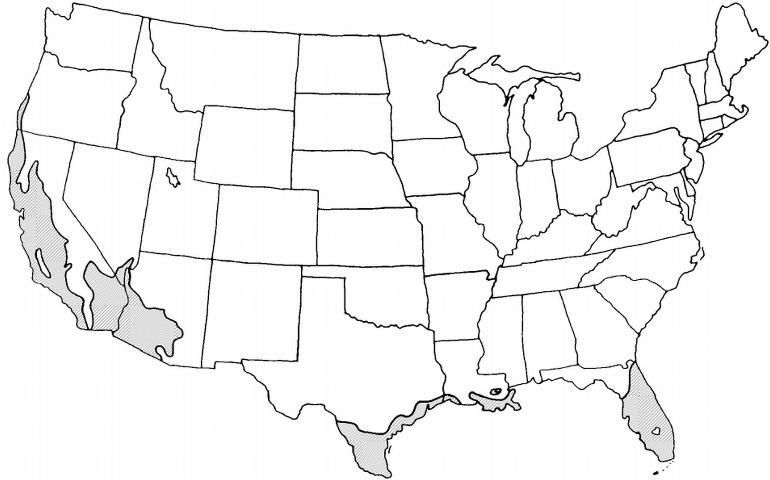Introduction
Yellow alder is a small shrub native to the Caribbean basin. Many stems originate close to the ground, but they branch infrequently forming an open, leggy plant. Those in the full sun branch more and stay fuller than those in partial shade. Clear yellow flowers are produced daily, each lasting several hours before closing at night. New flowers open the next morning. Leaves stay dark green with little or no fertilizer.

Credit: Edward F. Gilman, UF/IFAS

Credit: Edward F. Gilman, UF/IFAS
General Information
Scientific name: Turnera ulmifolia
Pronunciation: TERN-er-uh ul-miff-FOLE-lee-uh
Common name(s): yellow alder, yellow elder, ramgoat dashalong
Family: Turneraceae
Plant type: ground cover
USDA hardiness zones: 9 through 11 (Figure 3)
Planting month for zone 9: year-round
Planting month for zone 10 and 11: year-round
Origin: native to Central America, North America, Mexico, South America
Invasive potential: caution – may be recommended by UF/IFAS faculty but should be managed to prevent its escape (reassess in 2 years)
Uses: foundation; border; mass planting; ground cover; attracts butterflies
Availability: generally available in many areas within its hardiness range

Credit:
Description
Height: 2 to 3 feet
Spread: 2 to 3 feet
Plant habit: round
Plant density: moderate
Growth rate: moderate
Texture: medium
Foliage
Leaf arrangement: opposite/subopposite
Leaf type: simple
Leaf margin: serrate
Leaf shape: ovate
Leaf venation: pinnate
Leaf type and persistence: evergreen
Leaf blade length: 2 to 4 inches
Leaf color: green
Fall color: no fall color change
Fall characteristic: not showy
Flower
Flower color: yellow
Flower characteristic: year-round flowering
Fruit
Fruit shape: unknown
Fruit length: unknown
Fruit cover: unknown
Fruit color: unknown
Fruit characteristic: inconspicuous and not showy
Trunk and Branches
Trunk/bark/branches: not particularly showy; typically multi-trunked or clumping stems
Current year stem/twig color: green
Current year stem/twig thickness: medium
Culture
Light requirement: plant grows in part shade/part sun
Soil tolerances: acidic; alkaline; sand; loam; clay
Drought tolerance: moderate
Soil salt tolerances: unknown
Plant spacing: 36 to 60 inches
Other
Roots: usually not a problem
Winter interest: plant has winter interest due to unusual form, nice persistent fruits, showy winter trunk, or winter flowers
Outstanding plant: not particularly outstanding
Pest resistance: very sensitive to one or more pests or diseases which can affect plant health or aesthetics
Use and Management
Space plants several feet apart to form a ground cover in one season. To thicken the plant, cut stems back when they become leggy to force new branches close to the ground. To use as a low maintenance plant, consider locating alder alone as an accent in a shrub border or in a ground cover to display its natural open habit. It will display its bright yellow flowers on the outside edge of the plant without pruning. Alder seedlings often germinate near the plants and can become weeds in the landscape.
Plant yellow alder in the full sun or partial shade for best form and flowering. Plants appear to adapt to a variety of soil conditions including alkaline pH and dry sites. Freezing temperatures kill plants to the ground, but warm spring weather brings them back to life in central and south Florida.
Pests and Diseases
White flies are often found on the foliage. Severe infestations can injure the plants. Aphids and scales can also infest the foliage, but they are usually not too serious.